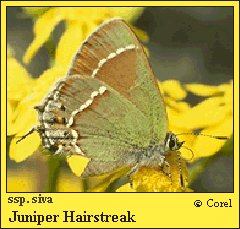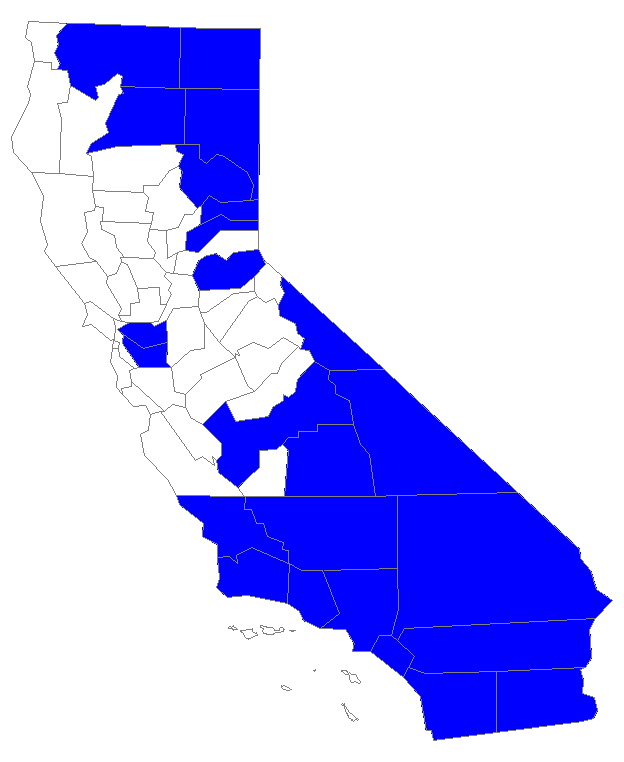 |
 

 |



Juniper Hairstreak (Callophrys gryneus [Hübner])
Wing span: 1 - 1 1/4 inches (2.6 - 3.2 cm).
Identification: Widespread and variable. Western and eastern populations were once considered separate species but have been found to hybridize. Western: Upperside of male dull red-brown, female tawny; both with dark brown costa and wing borders. Underside of forewing rust-red; hindwing dull to bright green with irregular white line edged inwardly with red-brown. Eastern: Upperside of male dark brown with olive-colored sheen, female blackish brown. Underside green; forewing with tawny base, hindwing with 2 white spots near base and irregular white line edged inwardly with red-brown.
Life history: To seek females, males perch on host trees all day. Eggs are laid singly on tips of host plant leaves, which the caterpillars eat. Chrysalids hibernate.
Flight: In the north, one brood from May-August; in the west, one brood from March-July. Two broods in the south from February-September.
Caterpillar hosts: Redcedar: (Juniperus virginiana), and (J. scopulorum), California juniper (J. californica), Utah juniper (J. osteosperma), and perhaps others.
Adult food: Nectar from various flowers including winter cress, dogbane, common milkweed, wild carrot, shepherd's needle, butterflyweed, white sweet clover, and others.
Habitat: Old fields, bluffs, barrens, juniper and pinyon-juniper woodlands, and cedar breaks.
Range: East: New England west to Nebraska, south to Florida and Texas. West: Montana, North Dakota, and Nebraska south to southern California, Arizona, New Mexico, and Baja California.
Conservation: Subspecies sweadneri is of conservation concern wherever it is found.
Callophrys gryneus as a whole has The Nature Conservancy Global Rank of G5 - Demonstrably secure globally, though it may be quite rare in parts of its range, especially at the periphery.
Subspecies siva and loki have The Nature Conservancy rank of T4 - Apparently secure globally, though it might be quite rare in parts of its range, especially at the periphery.
Subspecies sweadneri in Florida has The Nature Conservancy rank of T2 - Imperiled globally because of rarity (6 to 20 occurrences), or because of other factors demonstrably making it very vulnerable to extinction throughout its range. (Endangered throughout its range).
Management needs: Maintain habitat of subspecies sweadneri and manage for the proper successional stage.
References:
Opler, P. A. and G. O. Krizek. 1984. Butterflies east of the Great Plains. Johns
Hopkins University Press, Baltimore. 294 pages, 54 color plates.
Opler, P. A. and V. Malikul. 1992. A field guide to eastern butterflies. Peterson
field guide #4. Houghton-Mifflin Co., Boston. 396 pages, 48 color plates.
Scott, J. A. 1986. The butterflies of North America. Stanford University Press,
Stanford, Calif. 583 pages, 64 color plates.
Tilden, J. W. 1986. A field guide to western butterflies. Houghton-Mifflin Co.,
Boston, Mass. 370 pages, 23 color plates.
Author: Jane M. Struttmann
State and Regional References:
Brown, J.W., Real, H.G., and D.K. Faulkner. 1992. Butterflies of Baja
California. Lepidoptera Research Foundation, Beverly Hills, Calif.
Comstock, J.A. 1927. Butterflies of California. Privately published, Los
Angeles, Calif. [Facsimile available from Entomological Reprint
Specialists, Los Angeles, Calif.]
Dameron, W. 1997. Searching for butterflies in southern California.
Flutterby Press, Los Angeles, Calif.
Emmel, T.C. Editor. 1998. Systematics of western North American butterflies.
Mariposa Press, Gainesville, Florida.
Emmel, T. C. and J. F. Emmel. 1973. The Butterflies of Southern California.
Natural History Museum of Los Angeles County Science Series No. 26.
Garth, J.S. and J.W. Tilden. 1986. California Butterflies. California Natural
History Guide 51. University of California Press, Berkeley and Los
Angeles.
Langston, R.L. 1981. The Rhopalocera of Santa Cruz Island, California. Journal
of Research on the Lepidoptera 18: 24-35.
Miller, Scott E. 1985. Butterflies of the Califorenia Channel Islands. Journal
of the Research on the Lepidoptera 23: 282-296.
Opler, Paul A. 1999. Peterson Field Guide to Western Butterflies, revised
edition. Houghton Mifflin Co., Boston, Mass.
Orsak, L.J. 1977. The Butterflies of Orange County, California. Museum of
Systematic Biology, University of california, Irvine.
Stanford, R.E. and P.A. Opler. 1993. Atlas of Western USA Butterflies.
Privately published, Denver, Colo.
Steiner, J. 1990. Bay Area Butterflies: The Distribution and Natural History
of San Francisco Region Rhopalocera. Hayward, Calif.: Hayward State
University, Masters Thesis.
Tilden, J.W. and A.C. Smith. 1986. A Field Guide to Western Butterflies.
Houghton Mifflin Co., Boston, Mass.
Tilden, J.W. 1965. Butterflies of the San Francisco Bay Region. California
Natural History Guide 12. University of California Press, Berkeley and
Los Angeles.

